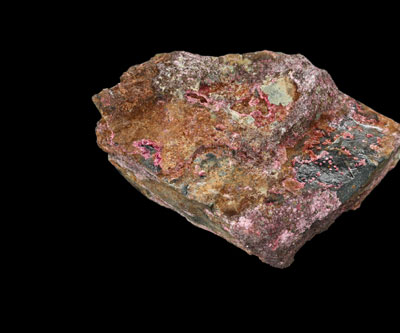Cobalt market may see more changes in 2014
 With 2013 behind us, the cobalt market will reflect on a year that saw minimal price movement despite a number of significant developments. New production capacity coming on stream in the Madagascar and the Philippines, Freeport Cobalt’s acquisition of the Kokkola refinery, and a proposed ban on concentrate exports from the DRC and subsequent increase in export taxes did little to profoundly impact market prices which, despite modest increases over the summer months, ended the year at a similar level to which they started it.
With 2013 behind us, the cobalt market will reflect on a year that saw minimal price movement despite a number of significant developments. New production capacity coming on stream in the Madagascar and the Philippines, Freeport Cobalt’s acquisition of the Kokkola refinery, and a proposed ban on concentrate exports from the DRC and subsequent increase in export taxes did little to profoundly impact market prices which, despite modest increases over the summer months, ended the year at a similar level to which they started it.
What will 2014 and beyond hold?
What should we expect to happen in the DRC in 2014?
Given its position as the world’s largest mine producer, developments in the DRC have the potential to significantly impact the market in 2014. The DRC government is known to want to increase domestic refining of copper and cobalt products and decrease exports of unrefined materials. The proposed export ban on concentrates did not come to fruition in 2013, but government rhetoric suggests that such measures could still go ahead in 2015.
Whilst a blanket ban remains unlikely, the 2013 increase in export tax, from US$60/t to US$100/t, could be the first in a number of changes. Gécamines, the state-owned producer, is in the process of conducting a review of its partnerships to determine whether its interests are being preserved. This review, together with the expected introduction of a new mining code which could see an increase in royalty and tax rates, could have profound implications for foreign companies operating in the country.
Reports that ENRC may be forced to sell its DRC assets might also have the potential to change the complexion of the DRC production landscape. If the reports are accurate, will an existing producer, or a new player, acquire ENRC’s assets?
What else lies in store, and where will new supply come from?
There are a number of potential mine projects that could produce additional cobalt raw materials over the next few years. However, the vast majority are at a very early stage of exploration or development and it is likely that very few new operations will come on-stream before 2018. Additional cobalt mine supply is most likely to come from expansion projects at existing producers such as those underway at Tenke Fungurume Mining in the DRC and African Rainbow Minerals in South Africa, and those being considered at Mirabela Nickel in Brazil, Moa Bay in Cuba, and Meta Nikel Cobalt in Turkey.
Another potential source of cobalt is from the numerous nickel producing operations that extract cobalt materials but do not recover them, such as those operations in the Philippines and New Caledonia which produce nickel materials for nickel pig iron (NPI) production in China. Similarly, Altona Mining in Finland produces a low-grade cobalt-nickel concentrate, which is currently stored, pending a treatment solution. These operations might look to produce cobalt if it was economical to do so.
Which sectors and regions will drive growth in demand?
Global consumption of cobalt has increased at a CAGR of 5.5% between 2008 and 2013. Roskill expects future demand to grow at a similar rate, expected to be 6.1%py to 2018. As a result, cobalt demand will reach over 110,000t.
Growth in demand for cobalt will be led by Asia, particularly China, South Korea and Japan. Growth in demand in these countries will be driven by increasing battery cathode production. Demand for cobalt in battery applications is forecast to grow at 9.2%py to 2018 and will continue to be the greatest contributor to increased demand. Demand for cobalt in catalysts is also expected to grow at a high rate (8.3%py), underpinned by high growth in demand for PET and in the oil and gas sector.
What changes to prices may be expected, if any?
Roskill expects the cobalt market to remain in a state of oversupply until 2016 when supply and demand are expected to be broadly in balance. However, it will take several years for the recent period of oversupply and resultant stockpiling to be reconciled, which is likely to keep prices in check over the medium term.
Roskill expects prices to continue on a slight downward trend in 2014 with the ramping up of new projects in Madagascar and the Philippines brining additional material into the market and compounding the current oversupply situation. Thereafter, Roskill expects a modest year-on-year increase in prices with high grade cobalt real prices increasing at roughly 3.6%py to 2018.
Will we see more of a shift to LME pricing?
The LME’s introduction of cobalt and molybdenum futures contracts in 2010 brought about an alternative to trade journal sourced pricing and introduced the option of regulated exchange pricing information. Uptake in switching to this new platform has been slow. However, in 2013 it was announced that Freeport-McMoRan Copper & Gold would use LME pricing data for some US$200 million worth of annual cobalt sales. Freeport said it will turn to LME-based pricing for cobalt and cobalt hydroxide supply contracts from January 2014.
It is unclear if other producers, traders or end users will choose to adopt LME-based pricing and it is commonly held that the trading volume will need to increase before more producers switch to LME pricing. It was reported in the Financial Times that ENRC planned to introduce an element of LME pricing into its contracts from 2014 when it will be selling its cobalt using a weighted average of the LME and Metal Bulletin prices. It is likely that if major producers such as Freeport and ENRC switch to LME pricing, then other smaller producers may follow suit.
Roskill’s new Cobalt: Market Outlook to 2018 contains full estimates for 2013, profiles on major producers and projects, an assessment of key market trends, an overview of developments in the DRC, and an outlook for supply, demand and prices to 2018. This latest edition is available, until the 28th February, at an introductory price of £4680 / US$7470 / €5580 from Roskill Information Services Ltd, 54 Russell Road, London SW19 1QL ENGLAND. Tel: +44 20 8417 0087, Email: info@roskill.co.uk Web: www.roskill.co.uk/cobalt.
More News
{{ commodity.name }}
{{ post.title }}
{{ post.date }}

Comments